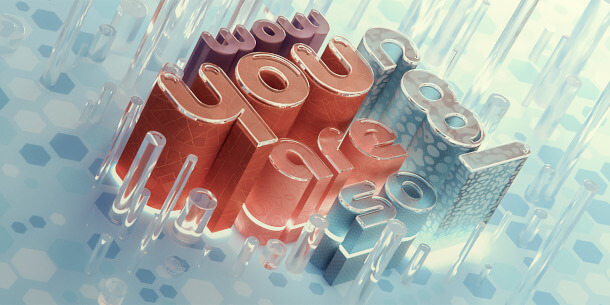Adobe ships Dimension 3.4

Originally posted on 15 April 2020.
Adobe has released Dimension 3.2, the latest update to its 3D rendering and compositing software aimed at “graphic designers, not 3D experts”.
The update adds a new 3D text system and a set of 3D primitives, opening up the possibility of using Dimension more like a traditional graphic design tool, but in 3D.
Other changes include a new colour temperature system for lighitng, new 3D camera controls, and the option to import models in USD format.
A designer-friendly drag-and-drop 3D rendering and compositing tool
Originally codenamed Project Felix before its commercial release in 2017, Dimension is intended to enable graphic designers with little experience of 3D tools to incorporate 3D elements in their work.
Users can import 3D models created in other software, assign materials, textures and HDRI lighting via a simple drag-and-drop workflow, and render images as layered PSD files for post-processing in Photoshop.
New in Dimension 3.2: 3D text
The major addition to Dimension 3.2 is the new text system, which makes it possible for users to create 3D text dynamically inside the software, with support for extrusion, bevelling and custom materials.
It supports a basic range of typographic features, including font family, font style, character and line spacing, and alignment.
A range of languages are supported, including Arabic, Hebrew and Indic and Asian languages, although layout is left-to-right only, even for languages written right-to-left or vertically.
Users can extrude text to a custom depth, or apply one of seven preset bevel styles: it’s possible to adjust basic parameters, like bevel width and angle, but there’s no bevel profile curve.
Dimension generates UVs for 3D text automatically, making the front, back, sides and bevel areas indvidual texture regions, so it’s possible to apply separate materials to each.
Adobe plans to expand the text system in future releases, although it doesn’t commit a specific schedule.
According to product manager Jeanette Mathews: “In the future, we can imagine things like stackable text layers, randomised text, offsetting position per-glyph, and the ability to add effects like bend”.
Six new basic 3D primitives
As well as text, Dimension adds a set of six 3D primitives – referred to as “customisable basic shapes” in the documentation – a cube, sphere, cylinder, plane, cone and torus.
Each can be customised via a basic range of parameters, although they have to be converted to non-parametric format before applying some of Dimension’s graphic layers.

Opening up new possibilities for 3D illustration and print design inside Dimension
Together, the text and primitives systems open up the possibility of using Dimension more like a traditional graphic design tool, but in 3D.
Whereas the software’s initial feature set was geared towards photorealistic workflows like product prototyping and visualisation, Adobe’s blog post on the 3.2 update shows a range of more stylised work.
As well as 3D typography of the type seen on posters and book covers, the post has some nice examples of illustration and brand design work based around simple, semi-abstract shapes.
Other changes: updates to lights, cameras and new 2D and 3D import formats
Updates to existing features in Dimension 3.2 include colour temperature for lights, with the colour picker now defaulting to natural light temperatures, and presets mimicking common real-world light types.
The 3D camera gets new sub-tools for Roll, Field of View, Tripod and the Dolly Zoom, plus the option to set Dimension to use the same navigation camera navigation controls as standard 3D applications.
There are also a range of new 2D import formats, including BMP, EPS, GIF, PSB, TGA and TIFF, on top of the existing support for JPG, EXR, PNG, PSD and SVG files.
The update also adds support for importing 3D models in USD format: now standard in visual effects and animation pipelines, but an interesting addition here, given Dimension’s target audience.
Updated 20 April 2020: We asked Adobe about USD support in Dimension. The firm told us that a key objective was to support the derived USDZ format used in Aero, its new augmented reality authoring tool.
Product market manager David Lloyd told us that supporting USD ensures that Dimension can integrate into AR workflows, but that its aim was also to offer “robust enough capabilities for 3D specialists”.

Updated 29 October 2020: Adobe has released Dimension 3.4.
The update adds the option to export a model’s UV layout in PSD format, intended to streamline the process of designing graphics for packaging in Photoshop or Illustrator.
Other than that, the only new features are the option to open .dn scene files by dragging them directly into the software, and support for Creative Cloud Team Libraries.
Since we last wrote about the software, June’s Dimension 3.3 update added support for SketchUp’s native .skp file format; plus automatic grouping of font families, and the option to favourite and filter fonts.
Pricing and system requirements
Dimension 3.4 – in the online documentation, it is sometimes also referred to as the September 2020 update – is available for Windows 10 and macOS 10.12+ on a rental-only basis.
A subscription to Dimension alone costs $20.99/month; a subscription to all of Adobe’s creative tools costs $79.49/month.
By: Jim Thacker/CG Channel

熱門頭條新聞
- Mumbai Comic Con 2025 to Host Indie Game Utsav
- Hirogami, an upcoming origami platformer from Bandai Namco Studios Singapore
- FUZE, the Social Platform for Gaming Communities, is Now Available on PC
- Puella Magi Madoka Magica Magia Exedra – New Opening Animation!
- The New Era of Gaming Comms
- Autodesk announces Betsy Rafael to step down from Board of Directors
- Bandit Trap Launches Public Beta, New Trailer Revealed at Future Games Show Spring Showcase 2025
- Hidalgo A Don Quixote’s Adventure Kickstarter is Now LIVE, a Game Inspired by the world’s First and Most Sold Modern Novel
